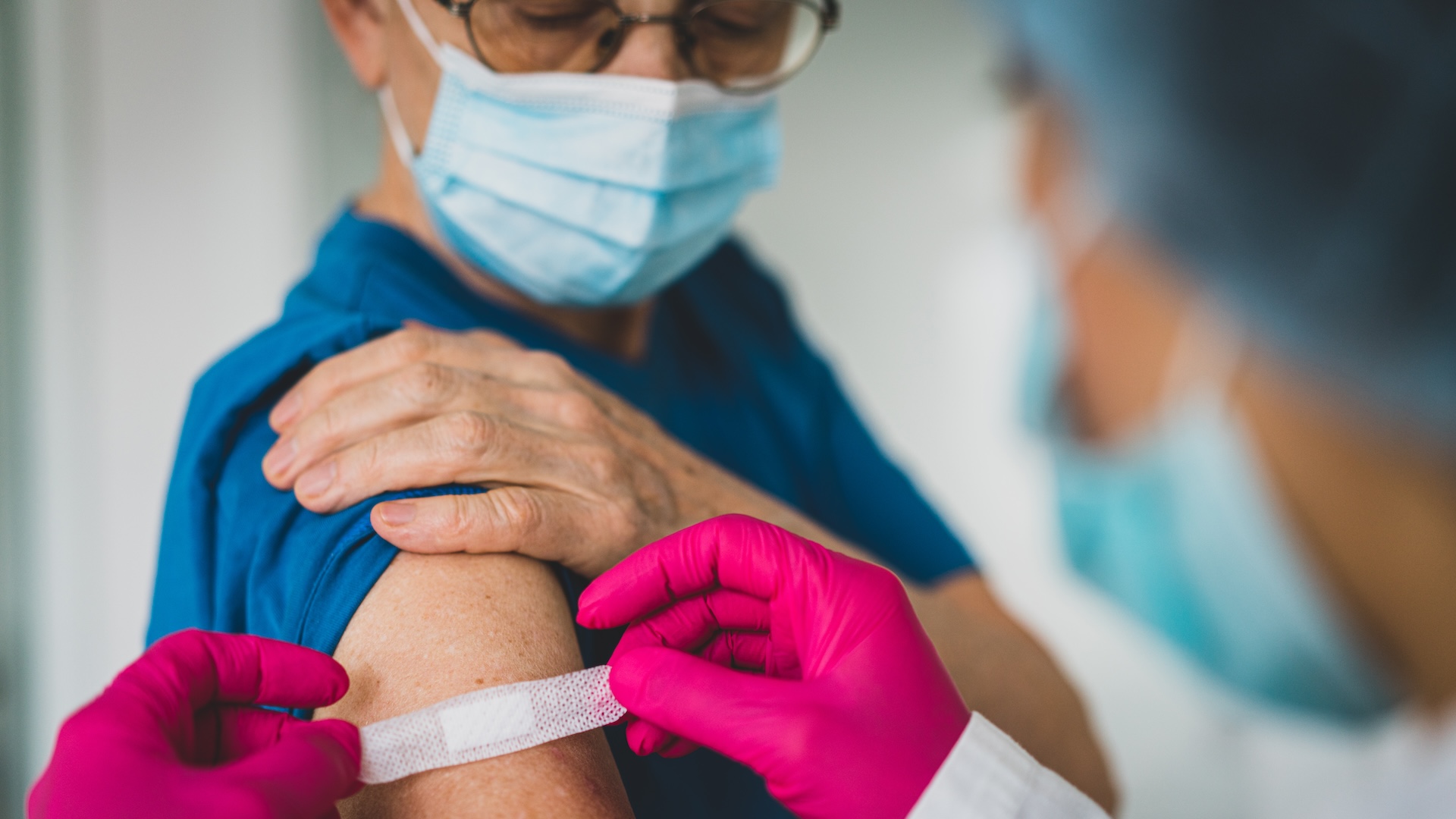What are the symptoms of COVID-19?
COVID-19 symptoms range from mild to severe, and some coronavirus variants have their own flavor of symptoms.

COVID-19 symptoms range from mild to severe, and some infected people show no symptoms, meaning they're asymptomatic. Although there are a wide spectrum of symptoms, the Centers for Disease Control and Prevention (CDC) has listed the 11 most common COVID-19 symptoms that appear two to 14 days after exposure to the coronavirus:
- Fever or chills
- Cough
- Shortness of breath or difficulty breathing
- Fatigue
- Muscle or body aches
- Headache
- New loss of taste or smell
- Sore throat
- Congestion or runny nose
- Nausea or vomiting
- Diarrhea
And according to the U.K. National Health Service, loss of appetite and feeling sick or being sick are also symptoms of COVID-19
Emergency COVID-19 symptoms
The following symptoms are emergency warning signs that you should seek immediate medical attention, according to the CDC:
- Trouble breathing
- Persistent pain or pressure in the chest
- New confusion
- Inability to wake or stay awake
- Bluish lips or face
- Other severe symptoms that concern you
Less common COVID-19 symptoms
There are other, less common symptoms that have been reported in COVID-19 patients.
For example, various skin rashes have been linked to COVID-19. "The rashes can take many forms — some appear as tiny red spots, while others appear as larger flat or raised lesions. Some have a hive-like appearance, while others look like frostbitten toes," with the latter dubbed "COVID toes," Live Science previously reported.
It's not clear whether these rashes are directly caused by the novel coronavirus, SARS-CoV-2, or related to other factors, such as a charged-up immune system in those infected with the virus, or lifestyle factors associated with the stay-at-home orders that were in place around the time the first cases of COVID toes were reported. Several studies found that COVID toes occurred even in cases where patients tested negative for SARS-CoV-2, raising questions about the underlying cause of the condition.
That said, a more recent study, published Oct. 5, 2021 in the British Journal of Dermatology, hinted that COVID toes might be partially driven by proteins called type 1 interferons, which switch on pathogen-fighting genes in immune cells, and autoantibodies, which inadvertently attack the body's own tissues, Live Science previously reported.
COVID-19 can also cause neurological symptoms. In addition to the loss of smell and taste, the virus can cause muscle weakness, tingling or numbness in the hands and feet, dizziness, confusion, delirium, seizures and stroke, according to Harvard Medical School.
How COVID-19 symptoms progress
A person with COVID-19 may have mild symptoms for about a week before rapidly worsening, according to Harvard Medical School. "Let your doctor know if your symptoms quickly worsen over a short period of time," the Harvard website notes.
In more serious cases of COVID-19, patients can experience pneumonia, which means their lungs begin to fill with pockets of pus or fluid. This leads to intense shortness of breath and painful coughing. In some people, the virus can also cause severe disease indirectly by triggering a "cytokine storm" or an overreaction of the immune system that can cause severe damage in the body, according to Harvard.
The CDC recommends that people with COVID-19 or any respiratory illness monitor their symptoms carefully. Worsening shortness of breath is a reason to seek medical care, particularly for older individuals or people with underlying health conditions, the agency notes.
COVID-19 symptoms in children
The risk of severe disease "increases steadily" with age, but younger people can also become severely ill when infected with SARS-CoV-2, according to Harvard Medical School.
Most children with COVID-19 have either mild symptoms or no symptoms, but some can become seriously sick, according to the CDC. Babies under the age of 1 year old and children with certain underlying conditions such as asthma or chronic lung diseases, diabetes, heart disease and obesity may be at an increased risk of severe illness, according to the CDC. A potentially serious but uncommon condition tied to COVID-19 in children is known as multisystem inflammatory syndrome in children (MIS-C).
In children, the most common symptoms of COVID-19 are fever and cough but they may also develop chills, nasal congestion or runny nose, loss of taste or smell, sore throat, shortness of breath or difficulty breathing, diarrhea, nausea or vomiting, stomach, tiredness, headache, muscle or body aches, poor appetite or poor feeding, especially in infants, according to the CDC.
Parents should "pay particular attention" to markers that can indicate COVID-19 in the child such as a fever of 100.4 degrees Fahrenheit (38 degrees Celsius) or higher, sore throat, a new uncontrolled cough that causes difficulty breathing, diarrhea, vomiting or stomach ache and a new onset of severe headache, especially if it's along with a fever, according to the CDC. If the child is showing any emergency signs (same as the ones listed for adults), the CDC recommends seeking medical care immediately.
What is MISC in kids?
A multisystem inflammatory syndrome in children (MIS-C) has also been associated with the novel coronavirus, according to the CDC. This syndrome is a condition in which parts of the body such as the heart, lungs, kidneys, brain, skin, eyes or gastrointestinal organs become inflamed. It's not yet clear what causes MIS-C, but children diagnosed with the condition often had COVID-19 or had been around someone who had COVID-19, according to the CDC. Several cases of MIS have also been reported in adults, and in these instances, the condition is known as MIS-A, Live Science previously reported.
The inflammatory syndrome was first described in April 2020 in the United Kingdom, when doctors began to notice an increasing number of kids coming in with severe symptoms that seemed to resemble Kawasaki disease, a rare childhood disease that causes inflammation of blood vessels and can lead to heart damage. Some of the symptoms also overlapped with those of toxic shock syndrome, a life-threatening illness caused by toxins released by certain bacteria. There have since been thousands of cases reported in the U.S. and worldwide, according to the CDC.
According to the CDC, symptoms of MIS-C include an ongoing fever plus two or more of the following symptoms:
- Stomach pain
- Bloodshot eyes
- Diarrhea
- Dizziness or lightheadedness (signs of low blood pressure)
- Skin rash
- Vomiting
These are not mild symptoms, so parents will likely notice them, The New York Times reported. For instance, the abdominal pain is not just a little bellyache but "severe enough for the parent to be worried," Dr. George Ofori-Amanfo, division chief of pediatric critical care medicine at Mount Sinai Kravis Children's Hospital in New York, told the Times. And the rashes, the Times reported, tend to be red, cover a large area, and usually appear on the hands, forearms and chest, turning white when you press on them, according to the Times.
If your child has a persistent fever above 101 degrees Fahrenheit (38.3 degrees Celsius), call your pediatrician.
Treatment includes supportive care to reduce symptoms, including steroids for inflammation, fever reducers and other medications, the Times reported. Children may also be treated with intravenous immunoglobulin (IVIG), a cocktail of various antibodies that serves as an anti-inflammatory treatment, Live Science reported.
As of March 1, 2022, there have been 7,459 reported cases of MIS-C across the U.S. and 63 associated deaths, according to the CDC.
Symptoms of omicron and other variants
The omicron variant of SARS-CoV-2 emerged in late 2021 and rapidly spread across the world, outcompeting the previous delta variant. Studies suggest that omicron is less adept at invading lung cells than other versions of the virus, Live Science previously reported. This fact, combined with the widespread availability of vaccination, means that infections with omicron tend to be less severe, on average, than delta infections.
The symptoms of omicron are similar to those of previous variants, according to the CDC. Because of the virus' tendency to invade the upper respiratory tract, symptoms may feel like a cold or sinus infection. Because the virus replicates much more quickly in the bronchi, or respiratory passages that carry air from your windpipe to your lungs, than delta, according to a paper posted to the preprint database bioRxiv on Jan. 3, 2022, symptom onset may be more rapid after exposure.
In general, the public health advice has not changed: COVID-19 can present as a mild head cold all the way up to a serious respiratory infection, and any respiratory symptom signals the need for a test.
Breakthrough COVID-19 symptoms
COVID-19 vaccines protect against infection with SARS-CoV-2, but they aren't 100% effective. As such, fully vaccinated people may still catch COVID-19, which is known as a breakthrough infection. But fully vaccinated people are much less likely to develop serious illness from COVID-19 compared with those who are unvaccinated, according to the CDC.
In particular, the omicron variant evades antibodies from vaccination and infection with previous variants, leading to an increased rate of breakthrough infections compared with previous variants. A third dose of an mRNA vaccine reduces the risk of a symptomatic infection, according to a March 2022 study in the New England Journal of Medicine; the mRNA vaccines include those produced by Moderna and Pfizer-BioNTech. The booster dose also provided 90% protection against hospitalization with omicron, according to a January CDC report, and reduced the risk of emergency room and urgent care visits 95% and 82%, respectively.
Omicron breakthrough cases are typically reminiscent of a cold or flu, according to MD Anderson Cancer Center Chief Infection Control Officer Dr. Roy Chemaly. Cough, runny nose, congestion, fatigue, sore throat, and headache are common. According to a Kaiser Family Foundation analysis of hospitalizations during the time period when the more-severe delta variant predominated, 69% of breakthrough hospitalizations were in people 65 and older, and 21% were in people 50 to 64. Only 10% were in younger patients. (In unvaccinated individuals, by contrast, 29% of hospitalizations were in those over 65, 30% were in 50 to 64-year-olds, and 41% were in those younger than 50.) These findings indicate that vaccines are protective, but that breakthrough infections can be more serious in older and immunocompromised people.
Additional resources
The CDC maintains a clearinghouse of coronavirus information and public health recommendations at its COVID-19 page. The United Kingdom's ZOE COVID Symptom Study provides information on COVID-19 infection rates and symptoms, provided by volunteers who opt in to report their experiences with the disease. The Mayo Clinic has more information on COVID-19 symptoms, including a self-check tool to help decide if you need to take a coronavirus test. You can also check out The American Academy of Dermatology Association for more information on skin conditions that could be caused by COVID-19.
U.S. residents can order a limited number of free at-home coronavirus tests at covidtests.gov.
Editor's note: This article was updated on March 15, 2022 to include updated information on common COVID-19 symptoms as well as those related to different types of infections.
Bibliography
Andrews, N., et al. (2022, March 2). Covid-19 Vaccine Effectiveness against the Omicron (B.1.1.529) Variant. The New England Journal of Medicine. doi: 10.1056/NEJMoa2119451
Demarco, C. (2021, December 29). COVID-19 breakthrough infections and the omicron variant: What to know now. MD Anderson Cancer Center. https://www.mdanderson.org/cancerwise/covid-19-breakthrough-infections-and-the-omicron-variant--what-t.h00-159466368.html
Harvard Medical School. (2022, January 26). COVID-19 basics. Harvard Health Publishing. https://www.health.harvard.edu/diseases-and-conditions/covid-19-basics
Hernandez, C., Bruckner, A. (2020). Focus on "COVID Toes." JAMA Dermatology, 156(9):1003. doi:10.1001/jamadermatol.2020.2062
Moyer, M.W. (2020, July 13). What We Know About the Covid-Related Syndrome Affecting Children. The New York Times. https://www.nytimes.com/2020/05/19/parenting/pmis-coronavirus-children.html
Peacock, T.P., et al. (2022, January 3). The SARS-CoV-2 variant, Omicron, shows rapid replication in human primary nasal epithelial cultures and efficiently uses the endosomal route of entry. bioRxiv. https://doi.org/10.1101/2021.12.31.474653
Thompson, M.G., et al. (2022, January 28). Effectiveness of a Third Dose of mRNA Vaccines Against COVID-19–Associated Emergency Department and Urgent Care Encounters and Hospitalizations Among Adults During Periods of Delta and Omicron Variant Predominance — VISION Network, 10 States, August 2021–January 2022. Morbidity and Mortality Weekly Report, 71(4);139–145. doi: http://dx.doi.org/10.15585/mmwr.mm7104e3
U.S. Centers for Disease Control and Prevention. (2021, August 2). Families & Children. https://www.cdc.gov/coronavirus/2019-ncov/groups/families-children.html
U.S. Centers for Disease Control and Prevention. (2022, March 1). Health Department-Reported Cases of Multisystem Inflammatory Syndrome in Children (MIS-C) in the United States. https://covid.cdc.gov/covid-data-tracker/#mis-national-surveillance
U.S. Centers for Disease Control and Prevention. (n.d.). Multisystem Inflammatory Syndrome (MIS). Retrieved March 12, 2022, from https://www.cdc.gov/mis/index.html
U.S. Centers for Disease Control and Prevention. (2021, February 22). Symptoms of COVID-19. https://www.cdc.gov/coronavirus/2019-ncov/symptoms-testing/symptoms.html
U.S. Centers for Disease Control and Prevention. (2021, December 17). The Possibility of COVID-19 after Vaccination: Breakthrough Infections. https://www.cdc.gov/coronavirus/2019-ncov/vaccines/effectiveness/why-measure-effectiveness/breakthrough-cases.html
Originally published on Live Science.
Sign up for the Live Science daily newsletter now
Get the world’s most fascinating discoveries delivered straight to your inbox.

Stephanie Pappas is a contributing writer for Live Science, covering topics ranging from geoscience to archaeology to the human brain and behavior. She was previously a senior writer for Live Science but is now a freelancer based in Denver, Colorado, and regularly contributes to Scientific American and The Monitor, the monthly magazine of the American Psychological Association. Stephanie received a bachelor's degree in psychology from the University of South Carolina and a graduate certificate in science communication from the University of California, Santa Cruz.












